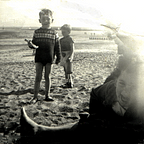Golden Slumbers
A key to Paul McCartney’s songwriting
Dad only wrote one song — to my knowledge- called Walking in the Park with Eloise. We recorded it with Wings….I told him about it afterwards. And he said, No, I didn’t write a song son. So I said, “But you did, “Walking in the Park with Eloise?” And he said, “No, I didn’t write it. I made it up.” Paul McCartney
Paul followed his father in the making up songs business. Interestingly Jim McCartney wanted his son to train formally rather than by ear: “… He wanted me to take lessons, to learn ‘the real stuff.” In The Lyrics, Paul muses on his rejection of this approach.
“I found lessons too restricting and boring. It was much more interesting to make up songs than to practise scales.
More lucrative, too. The songs had paid for a large house for his dad. This was a ‘five bedroom mock tudor place’ onthe posher side of the Wirral, and Jim shared it with Paul’s stepmother (Angie) and his step-sister, Ruth. Paul writes tellingly about the circumstances of his visit:
I hadn’t been back to Liverpool for a long time and here I was at my dad’s house, which wasn’t quite home … but was homeward
Evidently in nostalgic mood Paul approached his father’s piano. The process that would lead to the creation of Golden Slumbers is instructive.
I always looked in the piano seat because a lot of people have their sheet music in there. That’s where I first discovered Golden Slumbers … I can’t read music and I couldn’t remember the old tune, so I just started playing my own tune to it.
This version — in Lyrics — is slightly different from the one Paul tells in Anthology — where the music is on the stand. The essence, though, is that Paul approaches the score with the curiosity that others might have for a book in a foreign language. He is also instinctively confident that he can invent a new melody.
Writing a lyric is more challenging. Words are not like melody notes, they don’t come ‘flowing out like endless rain into a paper cup’ as Lennon puts it din Across the Universe. They always need work (see Scrambled Eggs to Yesterday) and usable ‘found’ ones are a good starting place.
Golden slumbers kiss your eyes,
Smiles awake you when you rise.
Sleep, pretty wantons; do not cry,
And I will sing a lullaby
According to Lennon these were ‘from an old book of 18th Century poetry, which is close enough. The Thomas Dekker lullaby was first published in 1603 in the play Patient Grissel. Paul liked them, anyway.
…they fitted with the words of another bit of song I had [Carry That Weight}.
The Recording
John Lennon was not present for the initial recording sessions on the 2nd, 3rd and 4th of July. He was still recovering from totalling his Austin in the Highlands. No Yoko either, of course, she would arrive (literally) on her sick bed later in the month.
During the Abbey Road sessions the collective interpersonal dynamic was better — perhaps not coincidentally in the absence of the royal couple. The three Beatles recorded fifteen takes but many of these were individual parts — take eight was a guide vocal for example
Perhaps the more relaxed mood also encouraged Paul to experiment — switching to rhythm guitar (George played lead and bass) adding piano and double tracking his own vocal. The playing is impressive and nuanced, Ringo’s crisp drum part contrasting with the gentle piano.
Key elements — most notably the vocal phrasing and distinctive dynamics, display McCartney’s skill as a musical craftsmen. As ever, this perfectly complemented by George Martin’s orchestral arrangement.
Twelve violins, four violas, four cellos and various horns were employed (all uncredited as was the policy). They add power and depth without overwhelming what McCartney conceived as ‘a gentle theme’.
McCartney on McCartney
The song turned out to be quite soulful and I think that’s what attracted me to those lyrics in the first place.
Paul deceptively plain descriptions mask a profound intuitive understanding of music theory. The transition into Carry That Weight, for example, is described by Macdonald as follows:
the rocking subdominant harmony of the preceding chorus firms up on the tonic before moving into an orchestral recapitulation of You’ve Never Give Me Your Money, followed by two restatements of that song’s closing guitar arpeggios.
Not sure that McCartney would have put it like that. But as Bernstein pointed out these innovations were not a fluke — but emerged from musical experimentation uninhibited by accepted conventions. Here Paul describes his approach to the dynamics
I remember trying to get a strong vocal on it because it was such a gentle theme…I ended up quite pleased with it.
One technique he uses to ‘get a strong vocal’ sudden switch to fortissimo for the second verse.
Ian Macdonald implies that there is an element of faux naïveté McCartney’s origin story for Golden Slumbers. He points out that the song picks up theme, mood and chord sequence (Am7-Dm-G7-C) of the opening segment of medley and suggests that
‘The composer was attempting something more ambitious than merely improvising a tune at random’
The term ‘at random’ is doing a lot of work here. Perhaps it is more accurate to say that McCartney was subconsciously improvising within the confines of his contribution to the medley. Sadness permeates the three segments (You Never Give Me Your Money, Golden Slumbers and Carry That Weight) but there is beauty, too, as The End approaches
